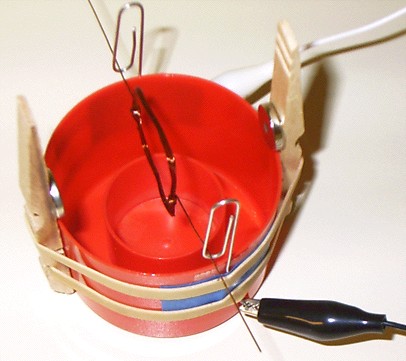Build a simple motor
To build this simple but strange motor, you need two fairly strong magnets (rare earth magnets about 10 mm diameter would be fine, as would larger bar magnets), some stiff copper wire (at least 50 cm), two wires with crocodile clips on either end, a six volt lantern battery, two soft drink cans, two blocks of wood, some sticky tape and a sharp nail.
| The supports for the axle can be made of aluminium, so that they make electrical contact. For example poke holes in a soft drink cans with a nail as shown. Position the two magnets, north to south, so that the magnetic field passes through the coil at right angles to the axles. Tape or glue the magnets onto the wooden blocks (not shown in the diagram) to keep them at the right height, then move the blocks to put them in position, rather close to the coil. Rotate the coil initially so that the magnetic flux through the coil is zero, as shown in the diagram.Now get a battery, and two wires with crocodile clips. Connect the two terminals of the battery to the two metal supports for the coil and it should turn. Note that this motor has at least one 'dead spot': It often stops at the position where there is no torque on the coil. Don't leave it on too long: it will flatten the battery quickly.The optimum number of turns in the coil depends on the internal resistance of the battery, the quality of the support contacts and the type of wire, so you should experiment with different values. As mentioned above, this is also a generator, but it is a very inefficient one. To make a larger emf, use more turns (you may need to use finer wire and a frame upon which to wind it.) You could use eg an electric drill to turn it quickly, as shown in the sketch above. Use an oscilloscope to look at the emf generated. Is it AC or DC? This motor has no split ring, so why does it work on DC? Simply put, if it were exactly symmetrical, it wouldn't work. However, if the current is slightly less in one half cycle than the other, then the average torque will not be zero and, because it spins reasonably rapidly, the angular momentum acquired during the half cycle with greater current carries it through the half cycle when the torque is in the opposite direction. At least two effects can cause an asymmetry. Even if the wires are perfectly stripped and the wires clean, the contact resistance is unlikely to be exactly equal, even at rest. Also, the rotation itself causes the contact to be intermittent so, if there are longer bounces during one phase, this asymmetry is sufficient. In principle, you could partially strip the wires in such a way that the current would be zero in one half cycle. |  |
